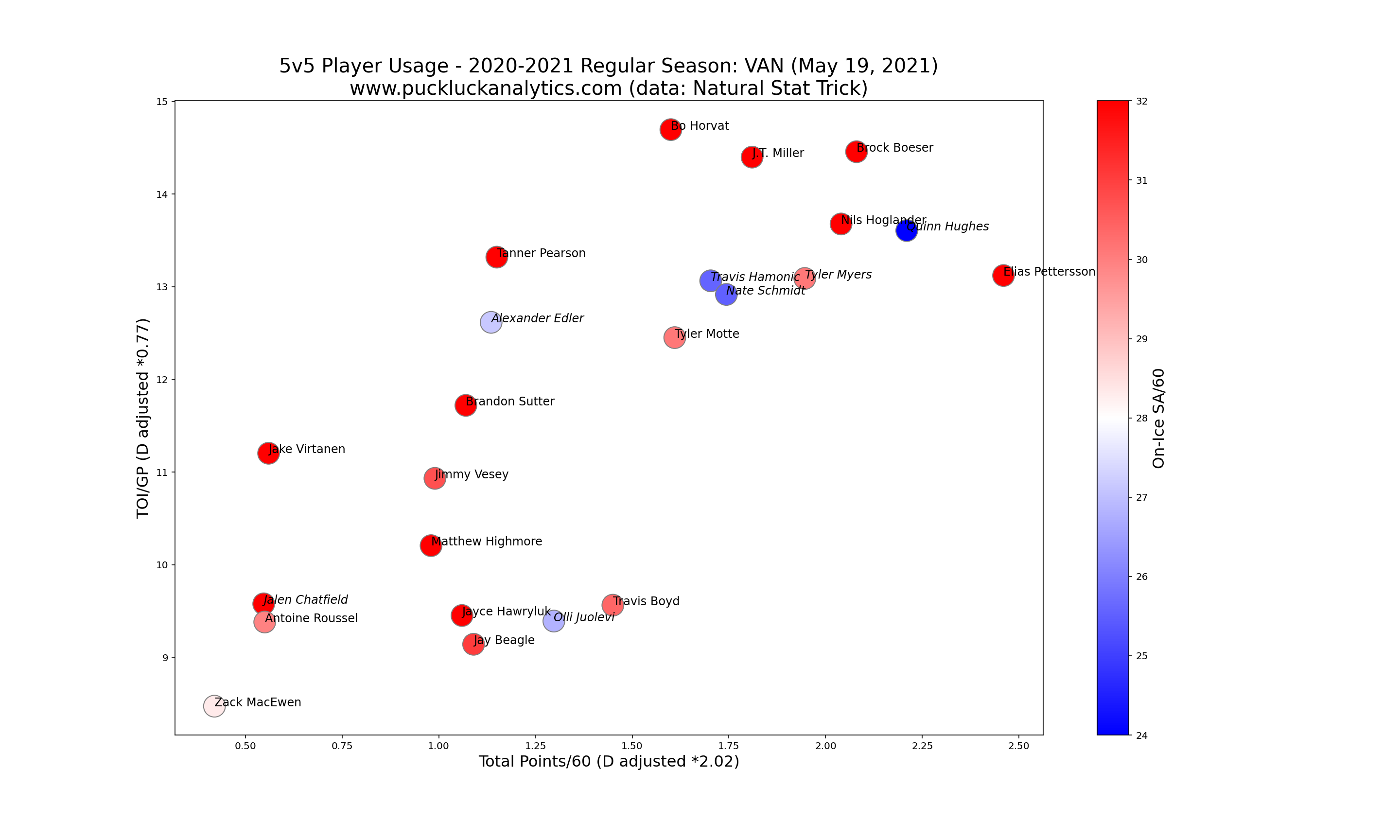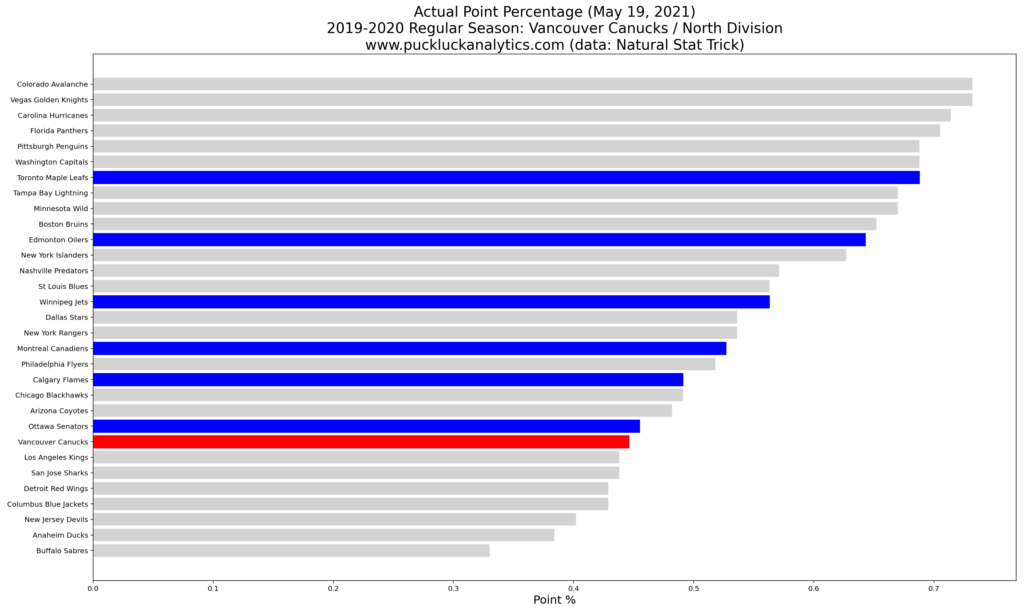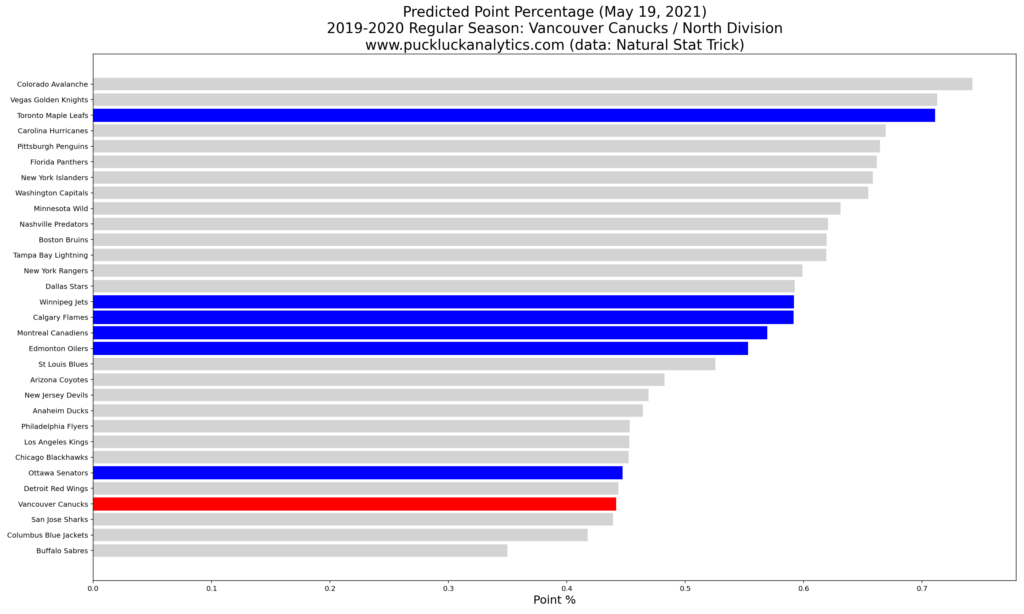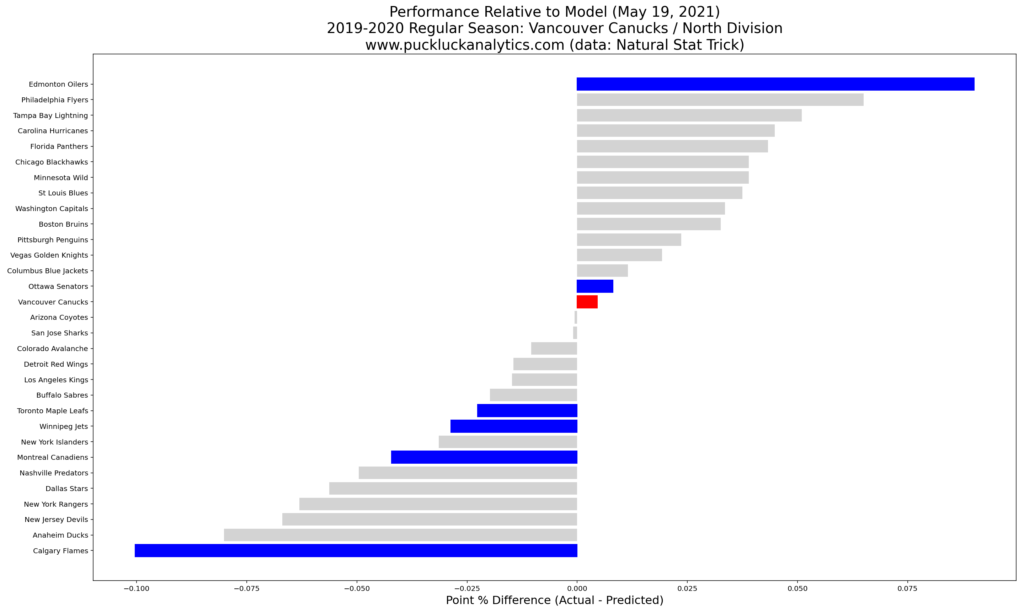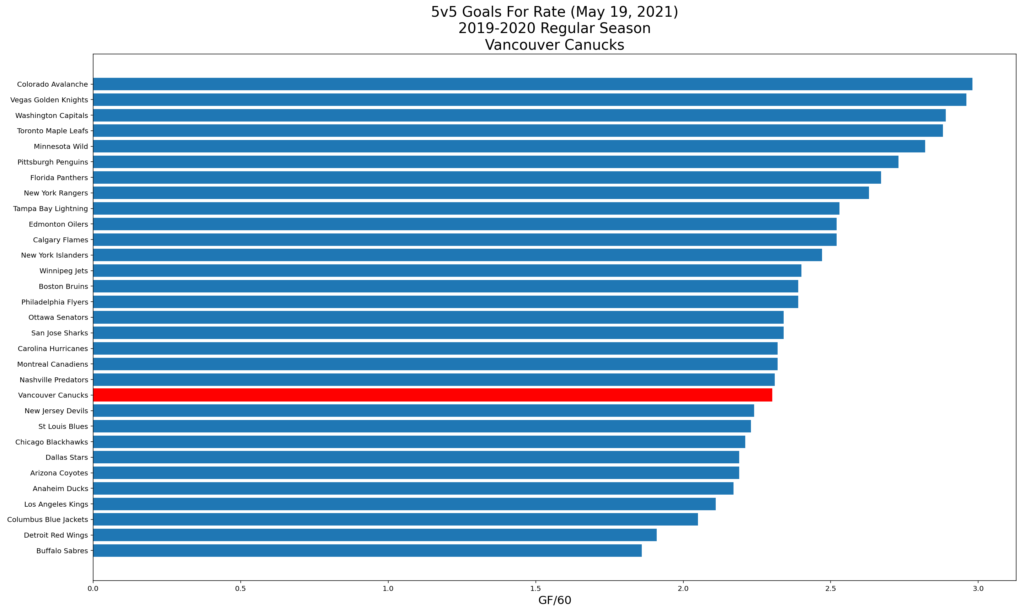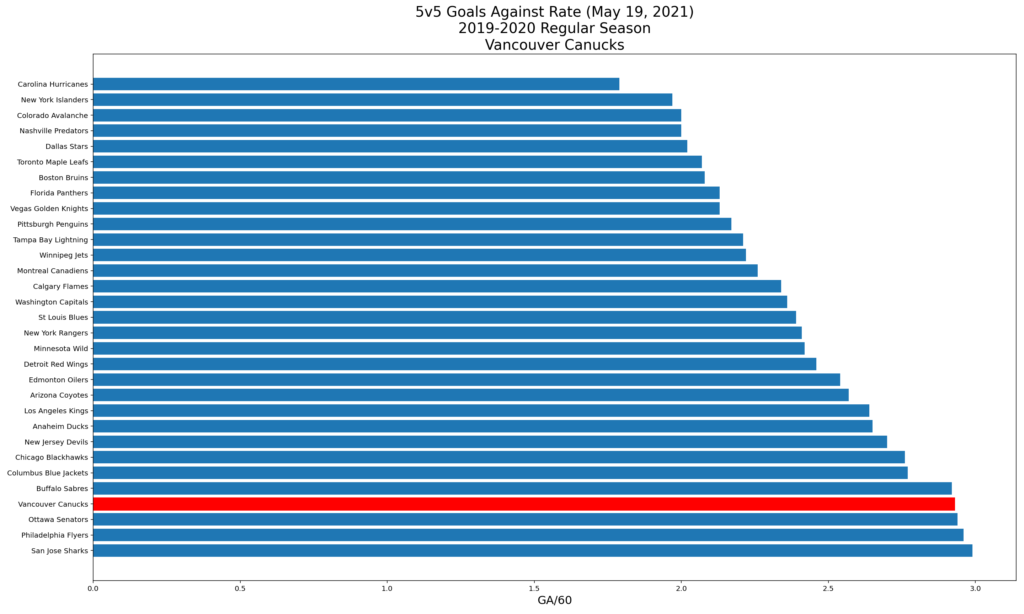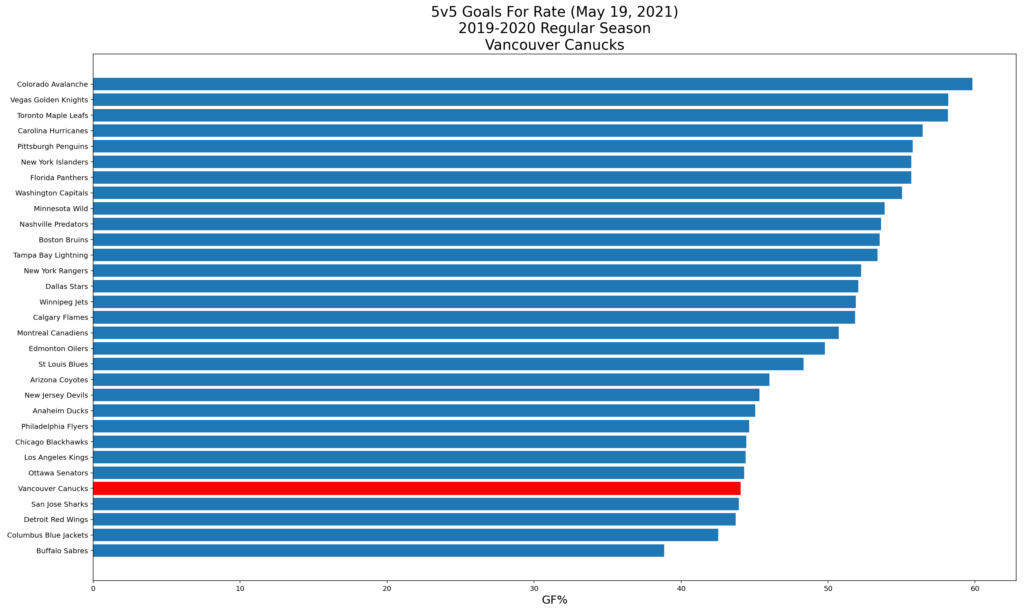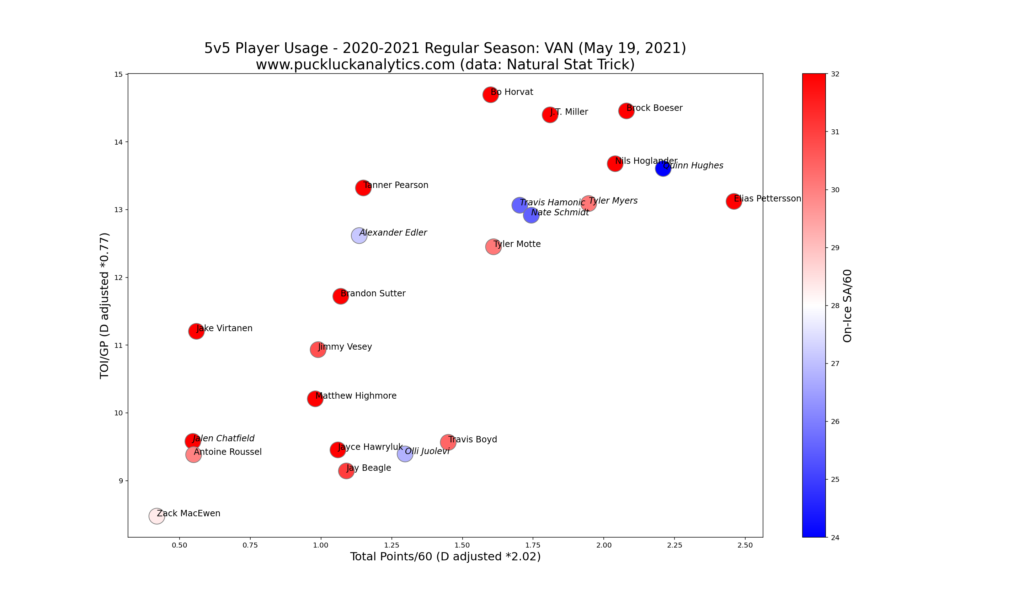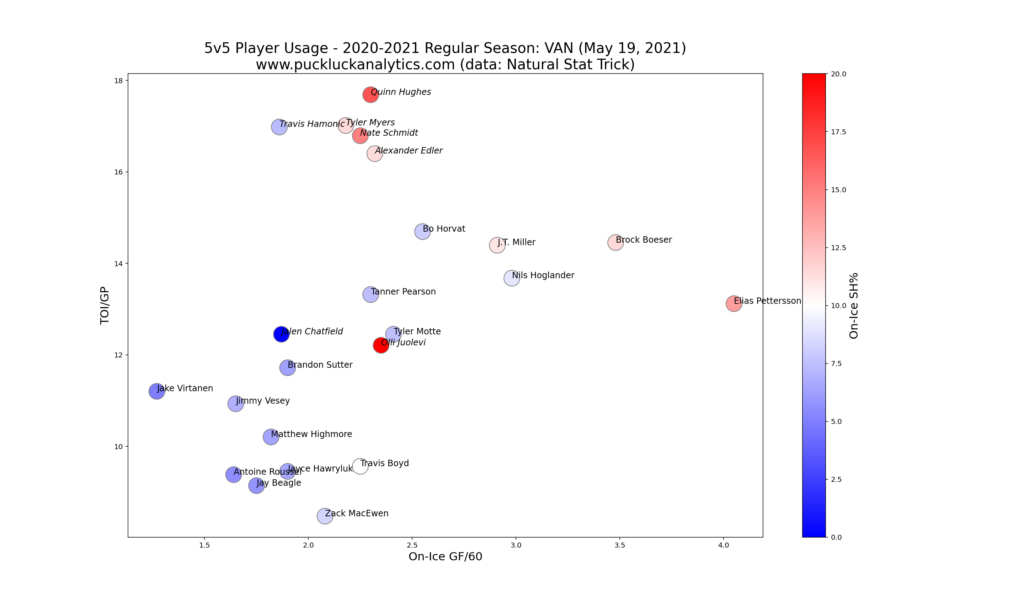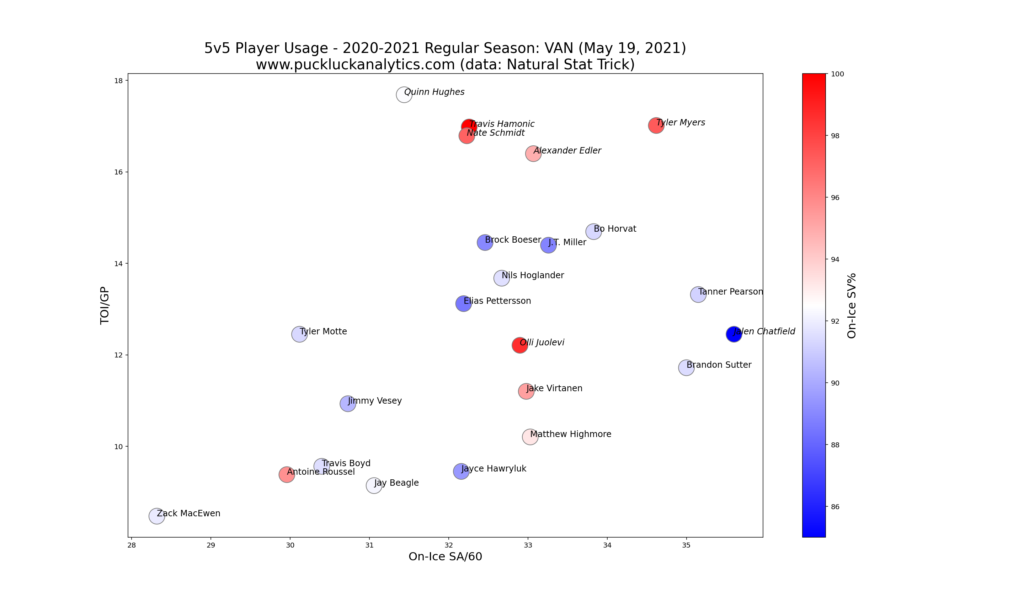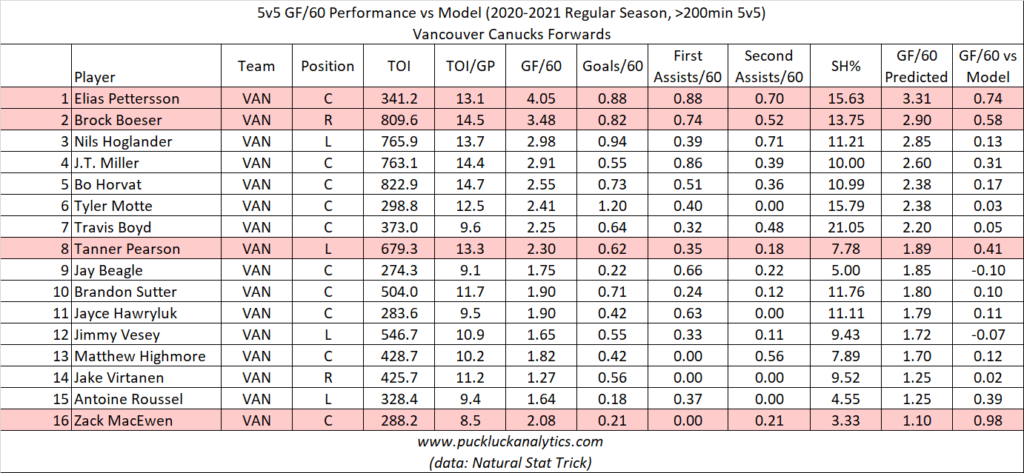With North Division play mercifully wrapping up regular season play on Wednesday afternoon, I’m ready to visit the first Canadian team in my season reviews as I look at the Vancouver Canucks. If you haven’t already, I suggest checking out this post that give some detail on what I’m looking for in my review.
After a second round exit from the playoff bubble last summer, the Vancouver Canucks had high hopes heading into the 2020-2021 season. With the emergence of Thatcher Demko in last season’s playoffs, the Canucks were looking to make some noise in the North Division. After a poor start, a period of exceptional play by Demko helped drag the Canucks back into the playoff race before a Covid outbreak derailed their season. Which version of the Canucks is the real one?
Overall Performance
The Canucks finished in last place in the North Division, left hanging one point back of the Ottawa Senators who were widely expected to occupy the bottom of the Division. Looking at the results from our points predictor model, which uses 5v5 goal rates as input, we see that it also puts the Canucks behind the Sens.
While the packed schedule after the Covid outbreak no doubt played a factor, the model results confirm that the Canucks were not a playoff quality team this season and their overall results are probably a reasonable reflection of the current team. Let’s take a look at the model inputs to see where they need the most improvement.
The Canucks 5v5 offense is not far off from being competitive. In fact, they sit ahead of one playoff team (St Louis) and are only three spots back of the Central Division champion Carolina Hurricanes. Defense, on the other hand, was a problem in Vancouver this season. Sitting in a group of 5 teams that stand out at the bottom of the 5v5 GA/60 rankings, their numbers are comparable with the lowly Sabres and the goaltending challenged Sharks.
Player Performance
We’ll start looking at player performance with a player usage chart that adjusts defensemen stats to be on par with forwards. This gives us a picture of the depth chart along the diagonal starting from the top right.
The Canucks youth movement is on display here, with Elias Pettersson, Brock Boeser, Nils Hoglander, and Quinn Hughes clearly leading the team. While losing Pettersson mid-season was a big blow to the Canucks, Hoglander arrived in the NHL with a very solid rookie campaign.
Let’s take a closer look at offensive impact by looking at on-ice GF/60 vs TOI/GP. We get a clear picture of which players had the largest impacts offensively here, with players further to the top right providing larger contributions to team GF/60.
It’s clear from this plot just how much the Canucks offense missed Petterson in the second half of the season. Yet we can see why the Canucks GF/60 was in the same ballpark as some of the playoff teams. Strong seasons from Hoglander, Boeser, and JT Miller led the way and the Canucks depth players produced at decent rates. The top five defensemen are grouped quite closely together which decent impacts showing that the Canucks offensive game wasn’t hampered with lower pairing defenders on the ice.
Defense was where the Canucks got in trouble based on the first few plots we looked at. Looking at on-ice SA/60 vs TOI/GP will give us a similar picture as the last plot, this time for defensive impact. Players closer to the bottom left contributed smaller impacts to the team GA/60.
It’s clear from this plot that team defense was a major issue for the Canucks. The league average on-ice SA/60 among players who played more than 200 minutes at 5v5 this season was 30 SA/60. The Canucks had only two skaters under the league average (Antoine Roussel and Zach MacEwen), both of whom were players in roles with limited ice time. While the young guns led the offense, their defensive contributions need to improve for the Canucks to become a competitive team.
Using our on-ice GF/60 models, we’ll look at which skaters had large variances from the model that might suggest a change in roles or line mates would help optimize their performance. Let’s start with the forwards.
Players who outperformed the model are generally aided by playing with high quality line mates. We see that Petterson and Boeser outperformed the model by significant margins, yet they are the top offensive players on the team. While there isn’t an immediately obvious reason why their performance varies this much from the model, it’s worth some consideration in expectations for next season. While their on-ice GF/60 may drop a bit, I expect their point totals will remain strong.
Tanner Pearson is another standout on the chart. In his case, there are stronger offensive players that may have helped his numbers. Digging deeper, we find that Pearson played nearly 80% of his 5v5 time with Bo Horvat and nearly 50% of his 5v5 time with Hoglander. It’s certainly possible that his numbers benefitted from playing with stronger players. Not great news for Canucks fans who recently saw Pearson extended for 3 years at $3.25M.
In a complete reversal from the forwards, the largest variances from the model among the Canucks defensemen are all negative. Generally, this suggests these players helped carry their line mates offensively. It’s a positive sign that we see youngster Quinn Hughes stand out in this fashion, suggesting he can provide a larger offensive impact next season.
Finally, let’s take a look at how goaltending contributed to the Canucks 5v5 GA/60 woes this season. As noted off the top, Demko was a wall for the Canucks and a strong stretch mid-season helped the Canucks fight their way back into the playoff race. However, while Demko’s play was strong, backup Brayden Holtby’s was not and he received roughly 40% of the goaltending duties. A sub 0.900 save percentage is not good enough in the NHL and they need more from the veteran they brought in to provide stability in goal. Combined with the Canucks penchant for allowing a high number of shots, we see why their overall defensive numbers were near the bottom of the league.
Looking Ahead
The Canucks have over $66M committed against the cap heading into the offseason. With a number of players headed to unrestricted free agency and two key RFAs to re-sign, it will be an interesting offseason in Vancouver.
Key RFAs:
Both Elias Pettersson and Quinn Hughes are restricted free agents this offseason. As two of the cornerstones of the Canucks future, Vancouver will certainly want to lock both players up. The challenge will be leaving enough cap space to fill out the rest of their roster with.
Key UFAs:
Forward Brandon Sutter and defenseman Alex Edler are the biggest names headed for unrestricted free agency. While they both provide veteran leadership, they aren’t producing at elite levels at this stage in their careers. The Canucks will likely have to look for more affordable options to fill their roster positions, depending on how much cap space the Petterson and Hughes deals leave.
Key Players Under Contract:
Horvat, Boeser, Miller and Hoglander helped lead the Canucks offense and will be looked to next season to do the same. Hoglander, in particular, is a key player that can provide a big impact while still on an affordable entry level contract. The Canucks also need Demko to continue his stellar play.
Tough Questions:
The Canucks are in a tight spot with the cap given they need to re-sign Pettersson and Hughes this summer. They need to fix their goaltending situation and may need to make some tough decisions to clear some cap space. Is a buyout an option worth entertaining? Holtby’s $4.3M cap hit certainly doesn’t look great after this season and he only has one year left on his contract. Can the Canucks find a trade partner willing to take one of Tyler Myers or Nate Schmidt’s $6M cap hits off the books?
Offseason Priority:
The Canucks are a few key pieces away being a competitive team and the priority this offseason needs to revolve around reducing their goals against. With Edler and Hamonic headed for free agency, the Canucks have an opportunity to make some changes on the back end that could help their defensive game. However, it will be a difficult task to make an upgrade with the cap space they’ll have to work with. They can also improve their defensive numbers with improved goaltending numbers from their tandem as a whole.
Check out some of my other season reviews that are up, including the Columbus Blue Jackets and Detroit Red Wings, and subscribe to catch the rest of the reviews as they come out.
data: Natural Stat Trick
cap data: CapFriendly
